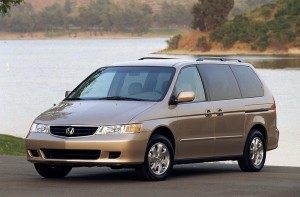
The average age of vehicles on the road in the U.S. is 11.5 years, or more simply, this 2003 Honda Odyssey.
While new car sales may be stronger than they have been in nearly a decade, most American motorists are riding around in vehicles that are older than ever.
The typical vehicle on U.S. roads is now 11.5 years old, according to a study by IHS Automotive, an all-time high. And that means that millions of those vehicles have now been in operation for more than two decades.
“As long as we have tracked average age, it has gradually risen over time due to the increasing quality of automobiles,” said Mark Seng, global aftermarket practice leader at IHS Automotive.
Vehicles are not only coming out of the factory with fewer problems, according to industry studies, but are experiencing fewer problems over the years, allowing motorists to keep them running longer.
But there are other factors that have contributed to the aging of America’s automotive fleet. During the depths of the recession, millions of car buyers postponed their purchases. So, “For the five to six years following the recession,” explained Seng, “average age increased about five times its traditional rate.”
More recently, the trendline has begin returning to normal as U.S. new car sales have jumped to an annualized rate of 17 million so far this year.
The number of registered passenger vehicles – cars, trucks and crossover combined – rose to 257.9 million, IHS noted. Of that population, 44 million have been on the road 16 to 24 years, up from 26 million in 2002. Meanwhile, another 14 million have been on the road since at least 1995, up from 8 million in 2002
A total of 81 million vehicles are six to 11 years old.
(Insurance companies unfairly use marital status to penalize motorists. For more, Click Here.)
According to an IHS summary of the new study, the consulting firm “forecasts that average age is likely to hit 11.6 years in 2016 but not reach 11.7 until 2018. The rate of growth is slowing as compared to 2008-2013 due to the recovery in new vehicle sales.”
Demand for used cars has been robust in recent years, and prices hit record numbers coming out of the recession. On average, industry observers estimate American motorists buy at least three “previously owned” vehicles for every new one.
(Click Here for details about Scion’s efforts to reconnect with young buyers.)
Even with improvements in vehicle quality, the aging of America’s vehicle fleet is good news for dealers and repair shops across the country who have to keep them serviced.
But some observers warn that there could be problems ahead for motorists, especially as newer vehicles add more high-tech features, from digital infotainment systems to radar anti-collision systems. Repairing or replacing such technologies can be even more expensive than some of the traditional mechanical systems, such as a blown transmission.
(To see more about how automakers are struggling to keep hackers out of cars, Click Here.)
And there are other concerns. As TheDetroitBureau.com reported last week, the National Highway Traffic Safety Administration is taking a closer look to see if airbags, among other safety systems, might start to fail as they age, a potentially serious issue considering they are found on virtually every vehicle built for the last quarter century.

When I chose cars to add to my “permanent” garage, I was able to pick, for instance, a 1990 300ZX which didn’t have airbags (which on ’93 and up would be standard). At my age the 4 cars there will never need replacing. But my sons won’t have the same opportunity – and I would fear keeping my daily driver cars for the 20+ years I have kept some in the past. I guess even cars will become expendable – you could make a good case for autonomous cars→ fewer accidents→ lighter weight+ more even speeds→ less engine wear→ smaller cheaper motors→ end-point controls (fewer heavy connections to physical driver controls) “by wire”→ etc etc.
Many people simply can’t afford a new vehicle or lease. The ones that can have been buying up new vehicles as fast as they can make them. At some point U.S. households will reach a saturation point with four or more new vehicles in their driveway. Then the auto companies will start laying off employees in droves as sales tank.
Repairing new vehicles with complicated infotainment systems is a nightmare and will prove costly – especially if you buy a vehicle that hackers can take control of via the infotainment system – which is a really, really irresponsible and insecure design.